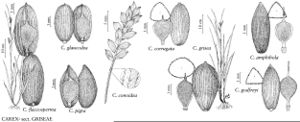Carex corrugata
Rhodora 44: 76. 1942.
Plants densely cespitose; rhizome internodes 1.2–2 mm thick. Culms dark purple-red to 4–35 (–39) cm high at base, 15–90 cm. Leaves: sheaths glabrous; blades green, widest blades 3.3–5.3 (–8) mm wide, smooth abaxially. Inflorescences 0.33–0.90 of culm height; peduncles of lateral spikes smooth or barely scaberulous; peduncles of terminal spikes 1.6–17 (–56) mm, usually barely exceeding lateral spikes; proximal bract sheath loose, abaxially glabrous, sheath front slightly concave to slightly convex, elongated 0.2–3.0 mm beyond apex; ligules 1.4–5.4 (–7.3) mm; distal bract much exceeding terminal spike. Spikes (3–) 4–5, distal 2–4 overlapping; lateral spikes pistillate, with 3–27 perigynia, 5–30 × 4.6–9.6 mm, ratio of spike length (in mm) to flower number = 1.3–2; terminal spikes 7–35 × 1.3–3 mm. Pistillate scales 2.7–6.6 × 1.2—2.4 mm, margins whitish, usually with redbrown speckles, entire, apex with awn 0.3–2.6 mm. Staminate scales 3.1–4.8 × 0.9–1.7 mm. Anthers 1.8–2.8 mm. Perigynia spirally imbricate, 52–64-veined, wrinkled to unwrinkled, narrowly ellipsoid to obovoid, obtusely triangular in cross-section, (3.6–) 3.9–4.5 (–4.7) × (1.7–) 1.8–2.3 (–2.4) mm, 1.8–2.3 (–2.5) times as long as wide, lustrous, base gradually tapered, apex gradually tapered; beak absent or straight 0–0.2 mm. Achenes broadly obdeltoid-obovoid, widest at (0.6–) 0.65–0.8 of body length, (2.4–) 2.8–3.1 (–3.3) × (1.6–) 1.7–1.9 (–2) mm, loosely enveloped by perigynia; stipe straight, (0.3–) 0.4–0.5 (–0.6) mm; beak straight, 0.3–0.6 mm.
Phenology: Fruiting spring.
Habitat: Wet-mesic deciduous forests, usually in calcium-rich, alluvial clays and silts on flood plains
Elevation: 0–300 m
Distribution

Ala., Ark., Fla., Ga., Ill., Ind., Kans., Ky., La., Md., Miss., Mo., N.C., Okla., S.C., Tenn., Tex., Va.
Discussion
Though largely overlooked in previous floristic works, Carex corrugata is actually a common and characterisitic element of flood plains of the southeastern United States. It is most common on the Coastal Plain, but ranges quite far inland, primarily along major rivers. It often associates with C. blanda, C. crus-corvi, C. granularis, C. socialis, and C. tribuloides. When it grows with C. grisea, as happens infrequently, C. corrugata usually inhabits finer-textured soils. Sometimes, C. corrugata grows with C. amphibola, which usually inhabits loamier and more acidic soils than C. corrugata.
Selected References
None.
Lower Taxa
"shortened" is not a number.
